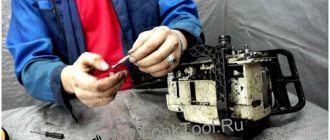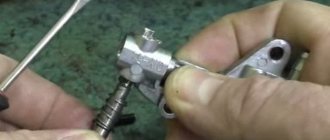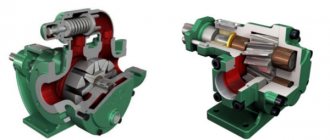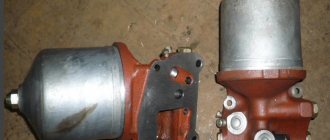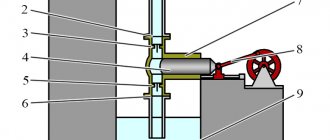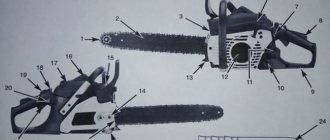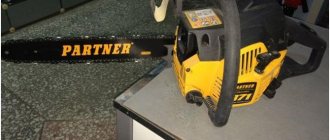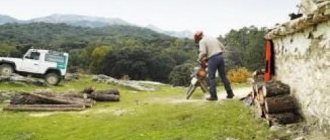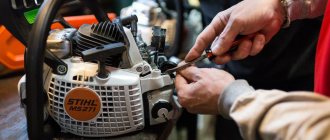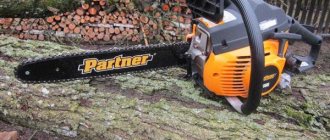Related Posts
Proper disassembly of a chainsaw
- Technological process of repairing a Shtil chainsaw
- Engine repair, ignition
- Chainsaw disassembly sequence
Disassembling a chainsaw is a very important moment that occurs at some point for the owners of such a tool. Owners of chainsaws have to carry out technical maintenance on their own. How to disassemble a chainsaw quickly and accurately?
Regular maintenance of your chainsaw will make working with it comfortable and safe.
In order for the chainsaw to work flawlessly, it is necessary to carry out frequent maintenance, consisting of several operations:
- oil change;
- topping up fuel;
- adjusting chain tension;
- cleaning dirt under the lid;
- chain brake inspection and repair;
- cleaning the oil supply system;
- tire cleaning;
- cleaning or replacing the filter.
Chainsaw diagram "Calm".
The time comes and all these operations must be completed. Therefore, you need to learn how to quickly and correctly disassemble chainsaws.
The Shtil chainsaw has long been loved by lumberjacks due to its low cost. It can be seen in the hands of summer residents, and city services do not refuse such a chainsaw.
However, among the many positive qualities of this model, there is one serious drawback. How to remove a magneto from a chainsaw. www.fassen.net. Chainsaws break down very often. Moreover, not every malfunction will be repaired in accordance with the warranty. How to remove the carburetor from a husqvarna chainsaw. You have to do the repairs yourself.
To do this you must have:
Technological process of repairing a Shtil chainsaw
Adjusting the chain brake
The chain brake often does not work due to grease or sawdust clogging the brake band and the space under the cover. All parts should be cleared of blockages. Perhaps the tape is simply worn out, then it needs to be replaced.
The operation of the chain brake is restored by mechanical cleaning
Some parts of a chainsaw wear out faster than others. These include the drive sprocket, tire, chain, and anti-vibration elements. For quick replacement, it is better to always have spare parts on hand. Don't neglect sharpening the chain.
Home page » How to Remove the Gas Tank from a Chainsaw
Chainsaw Partner 350: DIY repair, video
Today, almost every household has a chainsaw, which is a worthy replacement for axes and hand saws. The ideal solution for people living in a private house or involved in construction would be the Partner 350 hand chainsaw. This tool from a Swedish manufacturer is very convenient and compact, so it is suitable for any work in the garden.
However, improper care and intensive use of the unit can lead to its breakdown. In this case, it is not necessary to immediately contact a service workshop. Many problems can be fixed with your own hands. To do this, just study the structure of the saw and video instructions for its repair.
Design features of the Partner 350 chainsaw
- use saw of this model has a gasoline engine with a power of 1300 W. It is distinguished by easy starting, which is carried out due to the built-in professional fuel pump and electronic ignition system.
The chainsaw is equipped with a safety system that automatically activates a double inertial chain brake. The chain is also automatically lubricated. You can very easily change the chain tension of this unit using just two keys.
The chainsaw is equipped with a fuel primer, making it easy to start at any time of the year. The starter drum of the tool is equipped with a special impeller, with the help of which it is cleaned of contaminants.
A filter with a CCS system is able to capture all residual particles. In addition, this system allows you to use the air filter for a long time, while saving fuel consumption.
The piston group cylinder walls were equipped with a chrome coating, which significantly increases the service life of the tool.
Main malfunctions of the Partner 350 chainsaw
Most often, the cause of tool failure is associated with interruptions in the operation of the engine or other components and systems. Disassembly is required to resolve any problems. To do everything correctly, you need to know the design features of the chainsaw and the main reasons for its breakdown.
Checking the ignition system
First of all, if any chainsaw malfunctions, you should inspect the spark plug. To do this, first disconnect the wire, and then use a special key to unscrew the spark plug itself. By its appearance you can understand the cause of the problem:
To check the functionality of the spark plug, you need to put the ignition cable on it, connect the cylinder and the spark plug nut with pliers, and start the starter. If there is no spark , then the spark plug must be replaced.
Chainsaw fuel system repair
reasons why the fuel-air mixture does not enter the cylinder :
To diagnose a clogged filter or breather, you just need to disconnect the hose and watch how the fuel flows. The stream from the tank should flow out with good pressure . If it is intermittent and weak, then the filter needs to be pulled out through the neck of the tank and washed or replaced, and the breather should be cleaned with a needle.
A chainsaw carburetor is a rather complex device, equipped with many small parts. Therefore, it is better to entrust its disassembly and repair to specialists.
If the carburetor filter is simply clogged, you can carefully remove it, shake it out, wash it with detergents and put it back in place.
You can only adjust the carburetor with your own hands. This is done with three screws strictly according to the instructions.
Muffler cleaning
To eliminate this malfunction, the muffler is removed, disassembled and cleaned of carbon deposits using detergents. After this, you need to dry it with a hairdryer and install it in place.
While the muffler is removed, the saw's exhaust port must be covered with a clean rag.
Repair of cylinder-piston group
In this group, problems are quite rare. If any element breaks, it is most often replaced with a new one.
Main malfunctions of the cylinder-piston group:
- Engine power may be lost due to low (about 5 atm) pressure in the cylinder. To measure it, you need a special pressure gauge called a pressure gauge. The normal operating pressure of the cylinder is 8-9 atmospheres.
- If hot gases are released into the engine crankcase, the piston rings most likely become stuck.
- Loss of pressure and release of gases through cracks may indicate destruction of the cylinder head gaskets. They need to be replaced.
Breather clogged
The process of replacing and installing the breather and the breather fixation plug for Husqvarna chainsaws 236, 240.
The connecting rod mechanism of the Partner 350 chainsaw is quite complex. Its malfunctions are often accompanied by loud engine operation. It should also be noted that when the connecting rod mechanism breaks down, the carburetor often fails. In this case, it is more expedient to start repairing the Partner 350 chainsaw with your own hands by inspecting the ignition module. You will also need to fully check the coupling. In particular, the condition of the centrifugal clutch deserves attention.
In order to inspect it, you need to remove the top cover. The clutch itself in this model is located near the carburetor. To get to the centrifugal clutch in the saw, the flywheel is removed. Next, the carburetor head is disconnected. In this case, it is important not to damage the fuel system. The centrifugal clutch is bolted on.
The breather of the presented model becomes clogged when low-quality fuel is used. In such a situation, repairing the Partner 350 piston chainsaw should begin with inspecting the carburetor. In order to see it, you will have to remove the top cover of the device. Next, the ignition module is twisted. After this, it is important to immediately disconnect the crank. In this case, you will have to use keys. The next step is to disconnect the drum.
How to start a chainsaw
The effectiveness of any tool directly depends on compliance with the rules of its use. First of all, this concerns the launch. This should be done in the following sequence:
- Apply the chain brake by pressing it forward.
- Remove the protective cover from the tire, if equipped.
- Turn on the decompression valve, which will make the starting process easier.
- Press the fuel choke. This is necessary to reduce the number of swaps.
- Set the combination lever to the idle start mode all the way down, having previously locked the gas lever.
- Place the tool on a flat surface, grasp the chainsaw with both hands so that the cutting part is located at a distance from this surface. In this case, place your left hand on the handle, and your right hand near the starting cable. The tool needs to be secured with your foot, for which you can simply step on the back handle.
- Now the starting rope must first be pulled tight and then pulled several times. In this case, you need to move upward from the body.
- As a result of a short start, the engine will stall. Therefore, after this, the combination lever must be moved up one click, and then started again.
- If the engine is running, the throttle lever must be pressed and the combined engine must be switched to idle mode.
- Now the chain brake needs to be removed and you can start using the tool.
Despite the simplicity of the process, situations may arise when the chain saw still does not start. The reasons are not always related to tool failure. Perhaps not enough force was applied. If, after several attempts, the startup is unsuccessful, it is worth conducting a thorough inspection of the device.
Diagnostics and troubleshooting
The effectiveness of repairs also depends on correct diagnostics, because quickly identifying the problem will save time on repair work. If the Partner chainsaw does not work, then the diagnosis is performed in three stages:
- spark test;
- checking the presence of fuel in the cylinder;
- bearing diagnostics.
Most often, chainsaw problems are due to the fact that there is either nothing to burn or nothing to set on fire. Therefore, you first need to check the spark plug, for which you need to unscrew it, attach the wire to the cylinder, and then pull the starter. There may be no spark due to a defective spark plug, broken wires in the power circuit, a faulty ignition button, or lack of clearance between the flywheel and the coil (the flywheel key may also break from the crankshaft). Due to the lack of a spark, the chainsaw can start, but immediately stalls when you press the gas.
If there is a spark, then the fuel system requires checking, especially if it is discovered that the spark plug is dry. Diagnosis is as follows. You need to pour 5 ml of fuel through the spark plug hole, and then start the saw. If the launch is unsuccessful, then the CPG may wear out and a foreign body may enter it. If the saw starts up, the problem may be a malfunction of the carburetor or fuel line.
Diagnostics of the Partner chainsaw also includes checking for clearance in the crankshaft bearings. To do this, the flywheel needs to be moved in different directions. If there is a gap, then the bearings need to be changed.
There may be other malfunctions that you can solve yourself. For example, the saw does not gain speed or the chain is not lubricated. The first problem is due to improper carburetor adjustment, and the second is due to clogged hoses or insufficient oil in the fuel mixture.
No. 3. The engine "shoots"
If during operation there are extraneous sounds similar to gunshots, then there is a problem with the muffler or carburetor. How to make a chainsaw run quietly? It depends on which node is faulty.
Shoots the carburetor:
- Ignition is too late - the air-fuel mixture does not have time to burn out in the cylinder, so the sound is similar to a small explosion.
- Lean air-fuel mixture. Too little gasoline enters the mixture - the chainsaw, or rather the jets, needs to be adjusted to increase the fuel supply. Why the chainsaw revs on its own is for the same reason.
Shoots at the silencer:
Enriched air-fuel mixture. Why does a chainsaw “shoot”? There is too much gasoline and not enough air in the mixture, so the mixture does not completely burn out in the chamber and partially burns out in the muffler. Carbon deposits on the exhaust are a clear sign of this. The air filter needs to be cleaned or the carburetor adjusted.
How to set up a chainsaw
The chainsaw carburetor is adjusted to set the optimal number of revolutions for efficient operation of the tool. This is done by adjusting three main bolts:
- L - is responsible for setting the lower speed;
- H - upper revolutions;
- T - idle speed setting.
Some models have only one screw, the last one.
You can adjust the chainsaw only with the first two bolts. If the number of revolutions needs to be reduced, then they are turned clockwise, if increased, they are turned counterclockwise. In this case, first turn the first bolt (L), and then the second (H).
Additionally, you need to set the ignition. This work is performed if the saw does not start or begins to work intermittently. To do this, you need to either replace the spark plug or fix a broken wire.
The reason may also lie in an incorrectly set ignition angle.
A similar problem leads to the fact that a spark appears either before fuel is supplied, or after a long period after that. The required parameter can be found in the operating instructions for the chainsaw. Setting the ignition angle will help solve the problem.
Assessment of the condition of the cylinder-piston group
Often the engine does not start or does not operate at full capacity due to low pressure in the cylinder. It can be caused by wear of the piston or cylinder, stuck piston rings, or worn bearings. You can partially examine the condition of the cylinder-piston group (CPG) by removing the muffler and looking into the opened hole.
A compression gauge placed in the spark plug hole will help measure the compression in the engine - based on the measurement results, we can also talk about the condition of the CPG. Accurate data is obtained only after complete disassembly of the mechanism. If the piston is chipped or scratched, it needs to be replaced. The piston ring must be clean, free of carbon deposits, and be exactly in place.
Wear of the piston and crank mechanism is considered a serious problem
Based on the results of compression measurements, one can judge the condition of the CPG parts
DIY repair
Not all chainsaw malfunctions are related to carburetor failure or improper adjustment. In this case, you will have to repair the Partner chainsaw yourself, which is easy to do if you have the tools. This work is carried out in several stages, which depends on the cause and nature of the breakdown:
- Problems with the fuel system. Most often this is due to contamination of the fuel filter or breather. In the first case, you need to remove the fuel hose and clean it. It must be washed and dried thoroughly before reinstallation. As a preventative measure, it is recommended to change the fuel filter every three months. Additionally, it may be necessary to clean the breather, for which it is convenient to use a needle or thin wire. The air damper is cleaned in the same way.
- Chainsaw carburetor repair Partner. Adjustment does not always lead to the desired result. The cause may be clogged channels. You can use compressed air to clear the blockage. It must be remembered that reassembly can only be carried out if the parts are clean and dry.
- Muffler cleaning. If you need to repair a chainsaw when the tool starts to stall at high speeds, you will have to disassemble and clean the muffler. To do this, the part must be removed, all bolts unscrewed and disassembled. After this, use simple detergents to remove carbon deposits from all surfaces, and then dry thoroughly using a hairdryer. Under no circumstances should carbon deposits be removed using a dry method, as they contain substances that are hazardous to health and should not be inhaled.
Air purification system
Pre-filters can have different designs and consist of several elements, in particular, mesh (2) and snow (1) filters (see photo below).
The latter prevents snow from entering the air purification system and is used only in winter; at elevated temperatures it is removed.
Some chainsaw models use air purification using centrifugal forces at the pre-cleaning stage. The air flow is twisted by the flywheel impeller, causing impurities to be thrown out of the suction pipe into a fine filter.
Fine filters are made of diffusion foam, nylon mesh and other materials.
When a chainsaw is running, the air in its operating area is heavily contaminated with sawdust and wood dust. Excessive filter contamination reduces the amount of air entering the carburetor, which leads to a richer mixture and a decrease in the power of the chainsaw. Therefore, regular filter cleaning is necessary. It should be performed not only when dismantling the chainsaw for the purpose of repairing it, but much more often after long and dirty work. Cleaning is done using a method that depends on the type of filter material. most often by purging and washing.
How to disassemble a chainsaw
Repairing a chainsaw can only be carried out after the tool has been disassembled. It must be done as carefully as possible, and it is recommended to clean each part with detergent and dry thoroughly. Only after this is it possible to assemble the tool.
How to remove a star
To access the chainsaw sprocket you need:
- Remove the crankcase cover, chain set and bar, and then the air filter.
- Unscrew the spark plug and insert the piston stopper instead.
- Unscrew the clutch, first installing a puller in the hole for the universal key. This will allow access to the sprocket, after which the latter can be removed.
After the faulty part has been removed, the sprocket can be replaced with your own hands.
How to replace an oil pump
Removing the oil pump occurs in the following sequence:
- Remove the chain set, and then unscrew the bolts that secure the guide chain to the body.
- Now you need to remove the pump and divide it into two parts, then remove the gasket and put a new one in its place.
If such actions do not correct the problem, then the oil pump must be replaced. All assembly steps must be performed in reverse order.
Chainsaws Partner – troubleshooting and troubleshooting
Like other household equipment equipped with an engine, Partner brand chainsaws require repairs from time to time. This may be due to improper operation of the saw, or to simple wear and tear of spare parts. Be that as it may, the chainsaw needs to be repaired, and it is quite possible to do it yourself.
How to refuel a Partner chainsaw?
As the instructions indicate, to refuel the Partner chainsaw you should use gasoline of at least AI-92 grade. It must be mixed with oil designed for 2-stroke engines.
The optimal ratio of gasoline and oil for a Partner chainsaw is 50:1, that is, 20 ml of engine oil should be diluted in 1 liter of gasoline.
How to set the ignition on a Partner chainsaw?
If you cannot understand why the Partner chainsaw does not start, then first check the ignition system of your tool. Checking and adjusting the gap looks like this:
- First of all, remove the cover to which the starter is attached. To do this, we recommend using a T27 hex bit, tools included with the chainsaw, and additional attachments;
- Carefully inspect the ignition coil, flywheel with magnets and, especially, the gap between these parts. To do this, use a specially designed gasket;
- Installing the ignition on the Partner chainsaw is done by turning the screws, which brings the coil and flywheel closer to each other.
How to remove the clutch on a Partner chainsaw?
Repairing the tool clutch is often required in cases where the Partner chainsaw starts and stalls when you press the gas. However, not all novice gardeners know how to remove the drive sprocket from a Partner chainsaw. You can do this in this order:
- First turn the lever and remove the saw chain brake cover;
- Unscrew the nuts securing the clutch system using the wrench from the Partner chainsaw kit;
- Remove the clutch from the chainsaw and completely disassemble it. If necessary, replace worn parts and clean the walls of the standard clutch elements.
How to replace the oil pump on a Partner chainsaw?
If you find that the chain on your Partner chainsaw does not spin, then the cause of this problem most likely lies in the wear or breakdown of a separate pump designed to pump lubricant to the chain. The design of the oil pump includes 2 elements - a storage chamber and a working part. Repairing the pump involves disassembling the mechanism, but it is not recommended to take any actions with its working part. The next steps are as follows:
- Carefully inspect the inlet and outlet tubes through which the lubricant passes - as a rule, all pump malfunctions are associated with them;
- If the channels are clogged, then all debris must be removed. simultaneously blowing them with compressed air;
- If cracks appear on the channels, they need to be replaced;
If, after assembling the Partner chainsaw, the lubricant again does not pass to the saw chain, then the pump will need to be completely replaced.
How to adjust the carburetor on a Partner chainsaw?
Setting up the carburetor of Partner brand chainsaws is slightly different from the procedure with chainsaws of other brands. The difference lies in the markings and meaning of the adjustment screws. For adjustment, the manufacturer equipped the Partner chainsaw with three screws - the left fuel quantity screw, the right fuel quality screw and the “T” idle speed adjustment screw. All these screws are located on the left under the top cover of the chainsaw body. Adjusting the Partner chainsaw carburetor is as follows:
- Remove the cover and clean the parts underneath;
- Unscrew both screws fully clockwise and then turn them 1/5 turn in the opposite direction;
- Start slowly turning the quantity screw until you hear the motor start to run at its highest possible speed. Immediately after this, turn this screw ¼ turn in the other direction. As a result, the Partner chainsaw should hold idle speed steadily;
- Next, use the quality screw to set the maximum speed for the Partner chainsaw.
Clutch
At low speeds, elements with friction linings (1), which have a degree of freedom in the radial direction, are attracted to the center of the shaft by springs (2) and do not transmit rotation to the drum (3), connected to the sprocket chain drive.
When the speed of the chainsaw reaches values at which the centrifugal force exceeds the force of the springs, the friction segments are pressed against the inner surface of the drum and begin to rotate. As a result, the drive sprocket begins to rotate, which drives the saw chain. As you can see in the photo, the sprocket is located behind the clutch.
In other chainsaws, the sprocket may be located outside the clutch.
The main advantage of this type of coupling is that when the chain jams, the clutch with the chainsaw chain does not stall the engine and does not cause destruction of the mechanisms that transmit movement from the engine to the chain.
At low speeds, elements with friction linings (1), having a degree of freedom in the circular direction, are attracted to the center of the shaft by springs (2) and do not transmit rotation to the drum (3), connected to the sprocket driving the chain. When the chainsaw engine speed reaches values at which the centrifugal force exceeds the force of the springs, the friction segments are pressed against the inner surface of the drum and begin to rotate it. As a result, the drive sprocket begins to rotate, driving the saw chain.
As you can see in the photo, the sprocket is located behind the clutch.
On other chainsaws, the sprocket may be located on the outside of the clutch.
The main advantage of this type of coupling is that when the chain jams, the chainsaw clutch slips without stopping the engine or causing damage to the devices that transmit movement from the motor to the chain.
